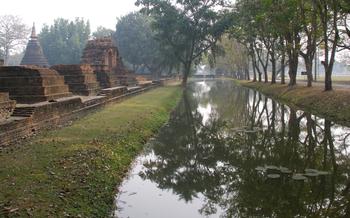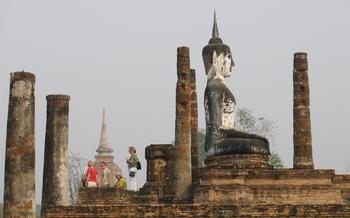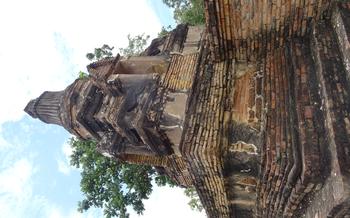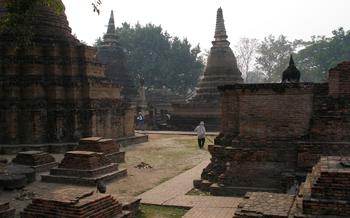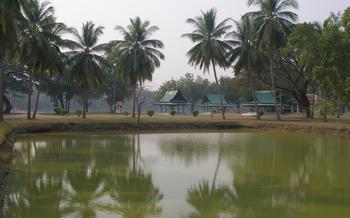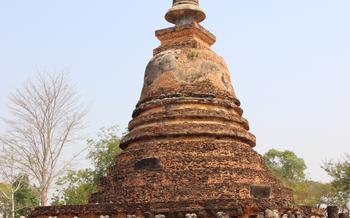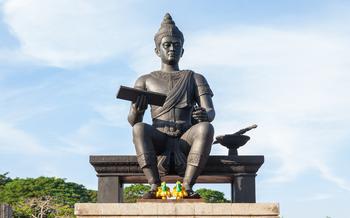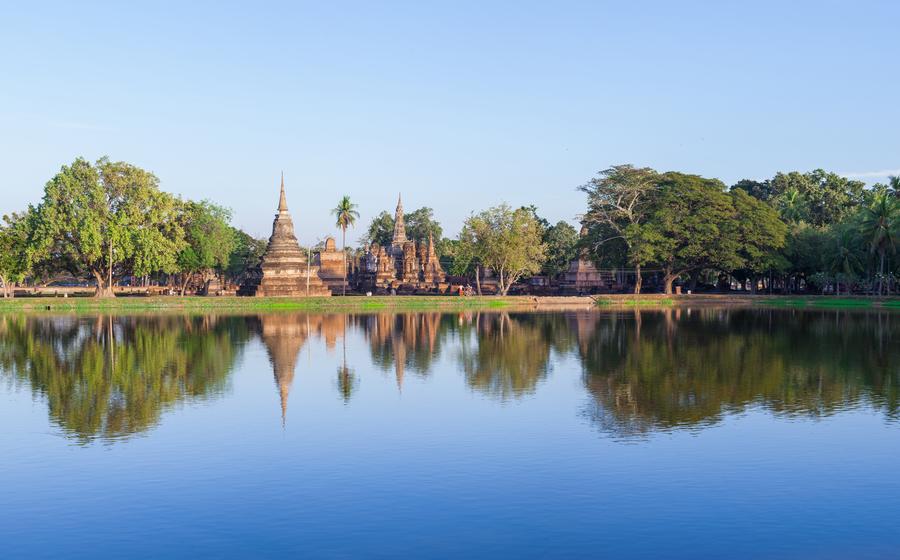
Wat Mahathat
- Historical Significance
- Wat Mahathat: A Sacred Legacy in Sukhothai
- Assembly Hall
- Ordination Hall: A Sacred Space for Buddhist Rituals
- Reclining Buddha: Symbol of Serene Release
- Walking Buddha
- Other Structures
- Historical Context
- Restoration and Preservation: A Legacy of Care and Respect
- Visitor Information
- Photography Tips: Capturing the Essence of Wat Mahathat
- Respectful Behavior
- Nearby Attractions:
- Insider Tip:
Historical Significance
Sukhothai, the ancient capital of the Sukhothai Kingdom, is a UNESCO World Heritage Site that offers a glimpse into Thailand's rich history and culture. Explore the ruins of this once-thriving city, founded in the 13th century by King Ramkhamhaeng the Great. Learn about the kingdom's rise and fall, and its enduring influence on Thai identity. Discover the unique architectural style of Sukhothai, characterized by slender prang towers and delicate stucco decorations. Immerse yourself in the history and beauty of this ancient city, and gain a deeper understanding of Thailand's cultural heritage.
Wat Mahathat: A Sacred Legacy in Sukhothai
Wat Mahathat, the most sacred and largest temple in Sukhothai Historical Park, stands as a testament to the grandeur and spiritual significance of the ancient Sukhothai Kingdom. Constructed during the reign of King Ramkhamhaeng the Great in the 13th century, Wat Mahathat served as the royal temple and a center of Buddhist worship. Its impressive scale, intricate architecture, and symbolic elements reflect the power and prosperity of the Sukhothai era, making it a must-see destination for visitors seeking to understand the kingdom's rich history and cultural heritage.
Assembly Hall
The assembly hall, also known as the wihan, stands as a significant structure within Wat Mahathat, serving as a gathering place for monks and devotees to engage in religious ceremonies and teachings. Its vast dimensions and open design create a spacious atmosphere, accommodating a large congregation.
Inside the assembly hall, visitors are greeted by a breathtaking array of Buddha images, each exuding a unique aura of serenity and devotion. Among these, the most revered is the Phra Buddha Si Sakyamuni, a resplendent golden image that captivates hearts with its serene expression and graceful posture. Seated upon a high pedestal, the Buddha emanates an aura of peace and tranquility, inviting visitors to pause and reflect on the teachings of the enlightened one.
As sunlight filters through the open doorways, the assembly hall is illuminated with a soft, ethereal glow, casting a mystical aura upon the Buddha images. The intricate details of their robes, the gentle curves of their faces, and the serene expressions in their eyes come alive in this golden light, creating a truly awe-inspiring sight.
Ordination Hall: A Sacred Space for Buddhist Rituals
The ordination hall, or ubosot, stands as a sacred space within Wat Mahathat, dedicated to the solemn rituals of Buddhist ordination. This structure holds immense significance in Thai Buddhism, marking the transition from a layperson to a monk, a profound commitment to the path of enlightenment.
The ubosot's architectural features exude an aura of reverence and austerity, befitting its sacred purpose. Its distinctive roofline, adorned with intricate carvings, draws the eye upward, symbolizing the spiritual journey undertaken by those who seek to embrace the monastic life.
Inside the ordination hall, the atmosphere is serene and contemplative, conducive to the transformative rituals that take place within its walls. Rows of Buddha images line the interior, each radiating an aura of peace and tranquility. Among these, the most revered is the Phra Buddha Si Sakyamuni, a masterpiece of Sukhothai art. This serene and elegant image embodies the essence of the Buddha's teachings, inspiring countless devotees and guiding them on their spiritual paths.
Reclining Buddha: Symbol of Serene Release
Within the sacred confines of Wat Mahathat, visitors are awestruck by the sight of the reclining Buddha, a monumental sculpture that exudes serenity and tranquility. Measuring an impressive 40 meters in length, this colossal figure rests gracefully on an elaborately carved platform, inviting visitors to contemplate the Buddha's final journey.
Crafted with exquisite detail, the reclining Buddha embodies the moment of parinirvana, the ultimate release from the cycle of rebirth. His serene expression, devoid of any worldly concerns, reflects the Buddha's attainment of enlightenment and liberation. The gentle curves of his body and the intricate folds of his robe convey a sense of profound peace and contentment.
As visitors gaze upon this majestic figure, they are reminded of the Buddha's teachings on impermanence and the futility of clinging to worldly possessions. The reclining Buddha serves as a symbol of letting go, surrendering to the flow of life, and embracing the ultimate truth of existence.
Walking Buddha
Amidst the array of remarkable structures within Wat Mahathat, the walking Buddha image stands out as a unique and iconic feature. This colossal statue, measuring over 15 meters in height, exudes a sense of grace and serenity as it depicts the Buddha in a striding posture, with one foot raised as if taking a step forward. The intricate details of the Buddha's robes and the gentle expression on his face reflect the exceptional craftsmanship of Sukhothai artisans. The walking Buddha holds significant symbolic meaning in Buddhism, representing the Buddha's compassion and his journey to spread his teachings. It serves as a reminder of the Buddha's tireless efforts to guide sentient beings towards enlightenment and liberation from suffering.
Other Structures
Within the expansive grounds of Wat Mahathat, visitors can also explore several other notable structures that contribute to the temple's grandeur and historical significance. The mondop, a square pavilion with a tall spire, is located to the east of the main stupa. It was used for housing sacred objects and conducting religious ceremonies. The wiharn lai, a smaller assembly hall, is situated to the south of the main stupa. It features a graceful roofline and intricate carvings, and was used for gatherings and teachings.
Additionally, there are numerous smaller stupas and Buddha images scattered throughout the temple complex. These structures vary in size and design, each offering a unique perspective on the artistic and religious traditions of the Sukhothai period. Exploring these lesser-known gems allows visitors to gain a deeper appreciation for the temple's rich history and diverse architectural heritage.
Historical Context
Wat Mahathat was constructed during a significant period in Thai history, the Sukhothai Kingdom (1238-1438). This kingdom, founded by King Sri Indraditya, emerged as a powerful force in the region, establishing its influence over much of present-day Thailand. Wat Mahathat served as a central religious and cultural hub during this time, reflecting the kingdom's devotion to Theravada Buddhism.
The temple's grandeur and elaborate architecture symbolized the power and prosperity of the Sukhothai Kingdom. It was a testament to the skill and artistry of the Sukhothai people, who created a unique architectural style that blended traditional Thai elements with influences from neighboring cultures.
Wat Mahathat also played a crucial role in royal ceremonies and rituals. The temple was the site of royal coronations, where the king would be crowned and receive the sacred water of ablution. This ceremony affirmed the king's legitimacy and authority, reinforcing the connection between the monarchy and Buddhism.
The temple's historical significance extends beyond its religious and political importance. It also served as a center of learning and education, where monks and scholars studied Buddhist scriptures and other subjects. The temple's library housed a vast collection of manuscripts and texts, contributing to the dissemination of knowledge and the development of Thai culture.
Restoration and Preservation: A Legacy of Care and Respect
Wat Mahathat, like many other ancient temples in Thailand, has undergone extensive restoration and preservation efforts over the centuries. These efforts have been crucial in maintaining the integrity and beauty of the temple while respecting its historical value.
The restoration process involves meticulous attention to detail, using traditional techniques and materials to ensure authenticity. Skilled artisans and craftsmen work tirelessly to repair damaged structures, replace missing elements, and restore the intricate stucco decorations that adorn the temple's surfaces.
One of the challenges faced during the restoration process is the need to balance the preservation of the original structure with the need for necessary repairs. Conservators must carefully assess the condition of each element and determine the most appropriate intervention to ensure both structural stability and historical accuracy.
Preserving Wat Mahathat is not just a matter of maintaining its physical structure; it is also about preserving its cultural and spiritual significance. The temple holds immense value for the Thai people as a symbol of their rich heritage and a place of deep religious devotion. By safeguarding Wat Mahathat, future generations can continue to appreciate its beauty, learn about its history, and connect with the spiritual essence that it embodies.
Visitor Information
To ensure a smooth and enjoyable visit to Wat Mahathat, it is essential to be aware of the following information:
-
Entrance Fees: There is a modest entrance fee for visiting Sukhothai Historical Park, which includes access to Wat Mahathat and other temples within the complex.
-
Visiting Hours: Wat Mahathat is open to visitors daily from 8:30 AM to 4:30 PM. Plan your visit accordingly to make the most of your time.
-
Dress Code: Visitors are expected to dress respectfully when visiting Wat Mahathat. Avoid wearing shorts, tank tops, or revealing clothing. It is advisable to wear comfortable and loose-fitting attire suitable for walking and exploring the temple grounds.
-
Best Time to Visit: To fully appreciate the tranquility and beauty of Wat Mahathat, aim to visit during the early morning or late afternoon. This will allow you to avoid the midday heat and crowds, creating a more serene and immersive experience.
-
Guided Tours: Consider hiring a knowledgeable guide or joining a guided tour to gain deeper insights into the history, architecture, and significance of Wat Mahathat. Guided tours can provide valuable information and help you make the most of your visit.
Photography Tips: Capturing the Essence of Wat Mahathat
Wat Mahathat's grandeur and intricate details make it a photographer's paradise. To capture stunning images of this iconic temple, consider the following tips:
-
Wide-Angle Lens: Use a wide-angle lens to encompass the temple's vastness and capture its imposing presence. This will help you fit the entire structure into your frame, showcasing its scale and majesty.
-
Tripod for Stability: Employ a tripod to stabilize your camera, ensuring sharp and blur-free images. This is especially important when shooting in low-light conditions or when using a telephoto lens.
-
Explore Different Perspectives: Don't limit yourself to the standard frontal shot. Walk around the temple, experimenting with different angles and vantage points. Try capturing the temple from a lower perspective to convey its towering height, or climb to a higher elevation to gain a bird's-eye view.
-
Lighting Conditions: Pay attention to the lighting conditions throughout the day. The best time to photograph Wat Mahathat is during the golden hours of sunrise and sunset when the warm light casts a magical glow on the temple's stupas and sculptures.
-
Unique Shots: Look for unique compositions that tell a story or convey the temple's atmosphere. Capture details like the intricate carvings on the stupas, the serene expressions of the Buddha images, or the interplay of light and shadow within the temple's corridors.
Respectful Behavior
As you explore Wat Mahathat, it is essential to remember that this is a sacred site for Buddhists and a place of worship for many devotees. Visitors are expected to behave respectfully and observe local customs. Dress modestly, covering your shoulders and knees, and avoid wearing shorts or tank tops. Maintain silence within the temple complex, and avoid talking loudly or making disruptive noises. Refrain from pointing your feet at Buddha images, as this is considered disrespectful. When encountering monks, greet them politely with a wai, a traditional Thai gesture of respect, with your hands pressed together in a prayer-like position. Observe local customs and traditions, and always ask permission before taking photos of monks or other people. By showing respect and understanding, you can contribute to preserving the sacredness and tranquility of this historic temple.
Nearby Attractions:
Sukhothai Historical Park is home to a wealth of other captivating attractions that visitors can explore after experiencing the grandeur of Wat Mahathat. Among these, Wat Si Chum stands out with its iconic prang, adorned with exquisite stucco decorations depicting scenes from the Thai epic Ramayana. Wat Traphang Thong boasts a unique blend of Sukhothai and Sri Lankan architectural styles, featuring a large Buddha image seated in a graceful posture.
History buffs will delight in exploring the Sukhothai Palace, the former royal residence of the Sukhothai kings. The palace complex offers a glimpse into the grandeur and opulence of the Sukhothai Kingdom, with its impressive halls, pavilions, and gardens. To delve deeper into the region's history, visitors can visit the Ramkhamhaeng National Museum, which houses a collection of artifacts and exhibits showcasing the rich cultural heritage of Sukhothai.
Insider Tip:
To make the most of your visit to Sukhothai Historical Park, consider exploring the lesser-known temples and ruins located beyond the main tourist areas. Take a bicycle ride or hire a tuk-tuk to venture into the surrounding countryside, where you'll discover hidden gems like Wat Chang Lom, a serene temple featuring a large reclining Buddha image, or Wat Saphan Hin, a picturesque temple set amidst rice fields. These off-the-beaten-path destinations offer a tranquil escape from the crowds and a chance to experience the authentic charm of Sukhothai's ancient heritage.
Insider Tip:
For an unforgettable experience, consider visiting Wat Mahathat during the annual Loi Krathong festival, typically held in November. During this festival, the temple complex is adorned with countless floating lanterns and illuminated with beautiful lights, creating a magical and serene atmosphere. As the sun sets, witness the sky filled with thousands of glowing lanterns, offering a breathtaking spectacle that will leave you in awe.

